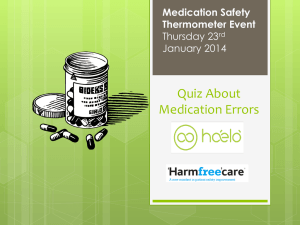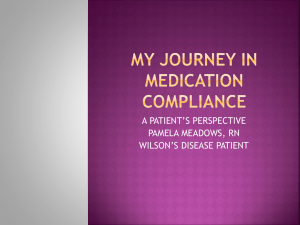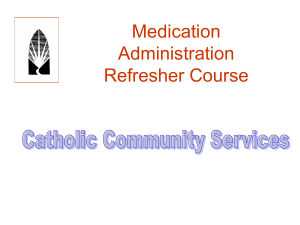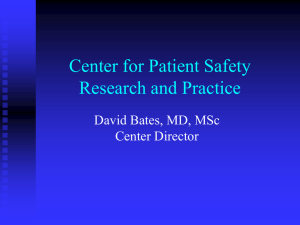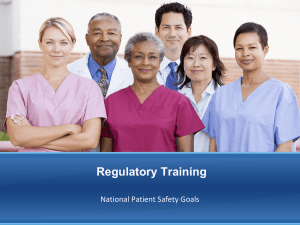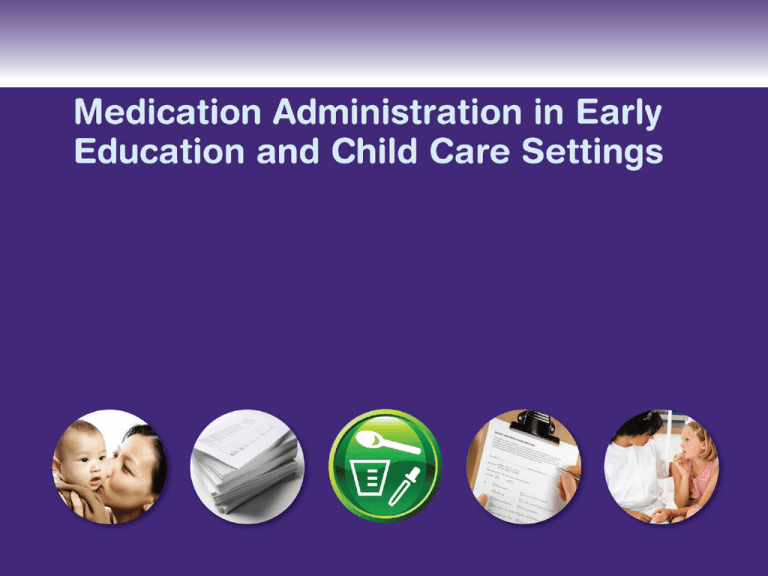
•Bullet Point #1
Original document included as part of Healthy Futures: Improving Health Outcomes for Young Children Medication Administration Curriculum. Copyright © 2009 American Academy of Pediatrics. All Rights Reserved.
The American Academy of Pediatrics does not review or endorse any modifications made to this document and in no event shall the AAP be liable for any such changes.
Medication Administration Curriculum - Module 1
Sources
•
Colorado: Guidelines for Medication Administration: An Instructional
Program for Training Unlicensed Personnel to Give Medication in Out-ofHome Child Care, Schools, and Camp Settings, Fifth Edition, 2008,
developed by Healthy Child Care Colorado
•
New Jersey: Medication Administration in Child Care developed by Healthy
Child Care New Jersey
•
North Carolina: Medication Administration in Child Care in North Carolina
developed by the Quality Enhancement Project for Infants and Toddlers, with
funding from the NC Division of Child Development to the Department of
Maternal and Child Health at the University of North Carolina at Chapel Hill
•
West Virginia: Medication Administration: An Instructional Program for
Teaching Non-Medical Personnel to Give Medication in Child Care Centers
in West Virginia developed by Healthy Child Care West Virginia and the West
Virginia Department of Health and Human Services
Medication Administration Curriculum - Module 1
Curriculum Objectives
1. Identify different types of medication, why medication
is given, and how it is given
2. Improve medication storage, preparation, and
administration techniques
3. Support good documentation of medication
administration
4. Recognize and respond to adverse reactions to
medication
5. Develop appropriate policies about medication
administration and implement them
Medication Administration Curriculum - Module 1
Disclaimer
• This curriculum provides education for personnel in the child care
setting who give medication to children but are not licensed
health care professionals
• It is not a substitute for written policy and professional medical
guidance
• It is not certification of competency
• Actual care must be based on the child’s clinical presentation, the
health care professional’s orders, parental guidance, personnel
experience and training, and facility policy
• Each program must review state laws, regulations, and
resources, and adapt accordingly
Medication Administration Curriculum - Module 1
What Is Covered in This Instructional Program
• Typical and routine medications for short-term use
• Medications taken on a regular basis for chronic health
conditions
• Emergency medications
Medication Administration Curriculum - Module 1
What Is Not Covered in
This Instructional Program
• Special medications like injectable or rectal medication
• Clinical explanation of the conditions being treated
(such as asthma)
• Principles of caring for children with special needs
• Dietary issues such as restrictions or supplements for
allergies or other medical conditions
These are important topics that are beyond the scope
of today’s program
• Introduction and reasons to give medication
• ADA, IDEA, state regulations
• Responsibility Triangle
• Types of medication
Medication Administration Curriculum - Module 1
Why Give Medication in Child Care?
What do you think?
Medication Administration Curriculum - Module 1
Why are Medications Given at All?
•
•
•
Prevent illness: Barrier cream to prevent diaper rash
Relieve symptoms: Fever reducing medications
Control or cure health problems:
– Short term: Antifungal cream to treat a fungal diaper rash
– Emergency: Albuterol for wheezing
– Long term: Anti-seizure medications
Medication Administration Curriculum - Module 1
Why Give Medication in Child Care?
• To maintain the health of the child
• To allow a child who is not acutely ill to attend the
program
• To comply with laws, regulations, and best practice
Medication Administration Curriculum - Module 1
When Should Medication Be Given?
• Medication should be given at home by
parents/guardians, if possible
• Prescribers should try to minimize the number of
doses given at a child care facility
Medication Administration Curriculum - Module 1
State Licensing Regulations
• Seek to ensure basic health and safety parameters
• Are minimal standards for a licensed program to
operate legally
Best Practice Standards
• Are optimal standards to strive towards
• Publications, such as Caring for Our Children, attempt
to set best practice standards
Medication Administration Curriculum - Module 1
What Does the ADA Law Say?
Centers have to make reasonable
modifications to their policies and practices
to integrate children, parents, and guardians
with disabilities into their programs
Medication Administration Curriculum - Module 1
How About Liability?
• Liability:
– something for which one is liable
– an obligation, responsibility, or debt
• Child care providers are more likely to administer
medication than to perform CPR in the child care
setting
• Review liability insurance for any stipulations related to
medication administration
Medication Administration Curriculum - Module 1
Responsibility Triangle
Parent/Guardian
Child
Child Care
Provider
Health Care
Professional
Medication Administration Curriculum - Module 1
Parent or Guardian Responsibilities
• Regular checkups and up-to-date immunizations
• Complete communication about child’s symptoms and
health status
• Consulting with their child’s health care professional
about diagnosis and care
• Compliance with medication policies and completion of
forms
• Communication with health care professionals about
the child care setting (environment, capabilities of
staff, hours that the child attends)
Medication Administration Curriculum - Module 1
Parent/Guardian Responsibilities, continued
• Asking the health care professional about whether
medication can be given at home and NOT in child
care
• Providing properly labeled medication and providing
appropriate measuring devices
• Providing up-to-date emergency contact phone
numbers
• Promptly picking up their child when notified of illness
• Arranging for back-up care
• Working constructively with child care providers to
determine when it is appropriate to care for their child
during mild illness
Medication Administration Curriculum - Module 1
Child Care Provider Responsibilities
• Careful, periodic monitoring of health records
(history, physical, immunizations, screenings)
• Practicing daily health checks
• Having and communicating clear policies on
medication, exclusion, and re-admittance
• Maintaining good hygiene practices
• Promptly communicating with parents or guardians
about their child’s symptoms
• Using available resources for health consultation
• Obtaining training about medication administration
Medication Administration Curriculum - Module 1
Health Care Professional Responsibilities
• Complete all child care health forms legibly
• Discuss medication needs with parent or guardian and if
needed, with child care providers, if parental permission is
obtained
• Adapt medication schedules to meet the needs of children
in child care and limit the number of doses that need to be
given in child care
• Provide guidance and education as requested
• Promote disease prevention and good health practices
• Be accessible to child care staff for questions and concerns
about their patients, with parental permission
Medication Administration Curriculum - Module 1
Child Care Health Consultant
• A trained health care professional who provides
consultation and technical assistance on health issues
in child care
• Child care facilities can request consultation from
professionals with special expertise
Medication Administration Curriculum - Module 1
Types of Medication
• Prescription (Rx), over-the-counter (OTC), and
non-traditional
• Brand name and generic
• Oral, topical, and inhaled, etc
Medication Administration Curriculum - Module 1
Prescription Medication
• Can only be prescribed by an authorized health care
professional
• Are dispensed by a pharmacist
• Are considered “controlled substances” if they can be
dangerous or addictive
– Controlled substances have special rules
• “Sample” medication must be properly labeled
Medication Administration Curriculum - Module 1
OTC Medication
•
•
•
•
•
Can be purchased without a prescription
Vitamins
Homeopathic medication
Herbal medication
Sun screen, insect repellant, and non-medicated
diaper cream often have different regulations
– Check your state regulations
Medication Administration Curriculum - Module 1
Common OTC Medication
•
•
•
•
•
•
Fever reducer or pain reliever
Antihistamines
Mild cortisone cream
Cough syrups and cold remedies
Nose drops
Medications used for common gastrointestinal
problems
• Many OTC medications do not have dosing
information for children under the age of 24 months
Medication Administration Curriculum - Module 1
Brand Name and Generic Medications
• Both prescription and OTC medications come as
– Brand name
– Generic
• This creates an opportunity for mistakes and confusion
– Names that are difficult to remember and to say
– Available under several names
– Sound alike names
•
Zantac® (reduces stomach acid) and Zyrtec® (antihistamine)
• Bacitracin® (antibiotic cream) and Bactrim® (oral antibiotic)
Medication Administration Curriculum - Module 1
Forms of Medication Video
Click button to play video
Medication Administration Curriculum - Module 1
Forms of Medication: Oral
Tablets
• Coated and uncoated: Swallow whole
• Chewable: Must be chewed, not swallowed whole
• Scored: May be cut in half
Capsules
• Swallow: Do not crush or chew
• Sprinkle: Do so only with health care professional
instruction
Medication Administration Curriculum - Module 1
Forms of Medication: Oral, continued
Liquid
• Suspensions: Undissolved medications in liquid
- Must be shaken prior to pouring
- Usually needs refrigeration
• Syrups: Sweetened liquids that contain dissolved
medication
• Elixirs: Sweetened liquids in a dilute alcohol base
which contain dissolved medication
Medication Administration Curriculum - Module 1
Forms of Medication: Oral, continued
Other oral medications
• Sublingual
– Placed under the tongue
• Melting strips and tablets
– Absorbed directly in the mouth
• Gums and gels
Medication Administration Curriculum - Module 1
Forms of Medication: Topical
• Drops: Eyes, ears, or nose
• Sprays: Nose or throat
• Patches
Medication Administration Curriculum - Module 1
Forms of Medication: Topical, continued
• Creams, Ointments, and Sprays for external
application of medication for rash or skin problems
– Prescription versus OTC
– Preventative versus treatment
Medication Administration Curriculum - Module 1
Forms of Medication: Inhalation
• Inhalation: Breathing or inhaling a drug into the
respiratory tract
• Methods include:
– Inhaler: Metered Dose Inhalant (MDI) or HFA
(hydrofluoroalkane), “puffer”
– Nebulizer: Mist created by a machine
– Powders: Turbohalers, discs
– Spray: Nasal, throat
Medication Administration Curriculum - Module 1
Forms of Medication: Injection
•
•
•
•
EpiPen® and EpiPen® Jr
Glucagon
Insulin
Need special training and will not be covered in this
program
Medication Administration Curriculum - Module 1
Forms of Medication: Suppository
• Suppositories are inserted into the rectum
• Need special training and will not be covered in this
program
• States vary, so check your local laws and regulations





